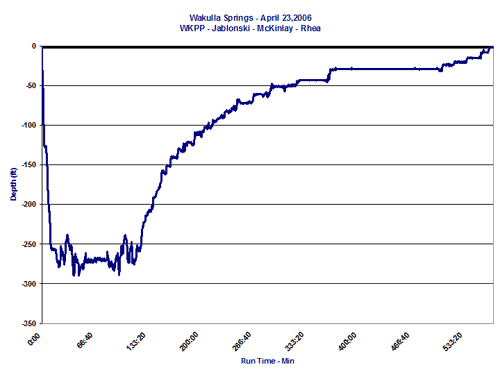WKPP Update - April 22-23
WKPP Update - April 22-23
WKPP
Update by Casey McKinlay
After more than six years, I was surprised to receive an e-mail on March 27 from Wakulla Springs State Park indicating basin conditions were crystal-clear and 100+ ft. Since the summer of 2000, the WKPP had been operating on a limited basis in support of various research projects, but exploration was never a consideration, given the poor visibility in the cave system. Blue water was a distant memory as we adjusted over the years to various shades of black, brown and green. In fact, many on the team had never seen the spring clear, so needless to say, this was exciting news. Exciting in that we may have a window to explore, but the amount of work necessary to bring everyone up to speed would be a formidable challenge. With the Chip’s Hole project now complete, we would have a few weeks to get everything and everyone on the same page. It was time to clear the schedule and switch gears.
- Prepare thirty safety tanks and thirty regulators – Extreme Exposure staff
- Prepare ten-fourteen Gavin scooters for exploration, survey and video work – Jarrod and Casey
- Prepare the RB80 setup and cleanup teams – Casey
- Prepare three-four dive plans with each building for the next dive
- Habitat maintenance in the Wakulla basin
- Prepare the media plan – print and video
- Convert all video equipment to High Definition (HD)
- Cancel all plans for two months < g >
Wakulla Springs Wildlife Festival
Each year, the WKPP hosts a booth at the Wakulla Springs Wildlife Festival to inform and educate the public about the spring, cave, research and exploration. Todd Kincaid and I hosted the booth this year, and despite the early-morning rain, the turnout was excellent. Given the current dark water and nitrate issues impacting the spring, many concerned citizens are taking an active interest in the spring and park. The WKPP has served as a resource to both the state and the public over the past fifteen years and spent the majority of the day explaining how the project does what it does and why this type of work is important to understanding the spring and dynamics in the spring basin. Late in the afternoon, both Todd and I gave presentations on work to date, including flow-meter maintenance, dye tracing and exploration in the surrounding cave systems. Saturday P.M.
Once the festival activities were wrapped up, the support team began to arrive. The objective was to complete the decompression setup in the basin for a Sunday setup dive into the system. As the operation kicked off around 4 pm, a tremendous thunderstorm hit the park with golf-ball-sized hail and reports of two tornados touching down within a few miles of the park. The setup guys hit the water immediately and worked through the storm placing deco gas for six RB80 divers in need of an early-morning start on Sunday. Sunday – April 23
With Shellie and Hunter running the surface and a small-yet-solid support crew, I felt confident we could knock things out and be back in Gainesville for dinner. Normally we do not operate on Sunday, but with the festival on Saturday and the risk of bad weather in the coming weeks we decided to make the most of the limited window and knock out one of several required setup dives. The plan was fairly basic, with some flow-meter maintenance worked in. We would re-stock safety cylinders out to 6,500 and pull the old cylinders. We would also place a new FGS Flowmeter at the A Tunnel – L Tunnel intersection and move the existing Flowmeter at the A/D Tunnel intersection another 100-200 feet farther out A Tunnel. Ambitious but doable. RB80 Team 1
(Jablonski, McKinlay, Rhea) We departed the Wakulla beach around 8 am with a total of nine safety cylinders. The cylinders were headed to 6,500 feet on this dive and would be moved to 11,000-foot and 15,000-foot depots on the next dive. The visibility in the cave was the best in six years, with almost no flow at the entrance restriction and 50-75 feet in A Tunnel. It was a nice change to not have to ride the line at 275-280 feet and instead ride 20-30 feet above the line as the team motored down A Tunnel. The D Tunnel intersection was crystal-clear with meter cables running down from the ceiling, coiled up on the floor and stretched to reach the flow meters. We hugged the left wall and made the turn south toward the K Tunnel intersection. The ride through K Tunnel was beautiful, and we merged back into A Tunnel around 5,500 feet to find a few small pockets of tannic water but overall the visibility was great. As we motored out, I could not help but notice the pace was extremely fast. The RB80 would prove to be much faster than the first-generation PVR unit. All the exploration schedules had been based on 100-125 feet-per-minute pace, but we were closer to 150-160 feet per minute. This would prove to be a huge advantage in planning the exploration dives. The team hit the rock at 6,500 feet and dropped the payload. The next piece of work was to drain the eighteen cylinders staged in 2003 and pull them back to the basin. It took close to fifteen minutes to drain all the tanks and pack everything up for the exit. Forty-two minutes in, eighteen minutes of work and forty minutes out would be enough for the day. The extra visibility and ability to ride high in the cave also helped to reduce the depth profile to 255 compared to the usual 275. RB80 Team 2
(Garland, Leonard, Miller) Safety cylinders needed to be delivered to 2,200 feet and 3,500 feet. The new FGS Flowmeter would need to be placed and the A/D Flowmeter moved farther out. In addition, the team needed to learn the cave for upcoming setup and cleanup dives. Todd was up to the challenge of the various assignments, and eager to guide the team in and out of the system. Team 2 delivered and set up the new flow meter at 1,400 feet. They also took a few minutes to capture the necessary placement data – depth, azimuth and tunnel dimensions with the handheld sonar. They repeated the process upon moving the A/D flow meter farther out A Tunnel and dropped fresh safeties at 2,200 feet and 3,500 feet. We passed team 2 in action at the A/D intersection and they appeared to have everything under control as we continued on with the empty cylinders. Team 2 joined us at deco shortly thereafter and moved their way up to the slope as David Rhea captured photos in the blue water. I was pleased that we decided to make the most of a short weekend and knock out a critical setup dive. The support team was outstanding as usual, with top-notch support from Derek Bennett, David Lennon, Kell Canty, Robert Bognar, Doug Mudry, Walter Gordon, Curtis, Bob Bourke, Brian Swearingen, Chris Werner and Hunter and Shellie running the surface. Thanks to Sonya for support and excellent photo coverage. The stage was set for round 2. Dive Profile


